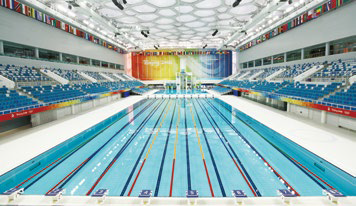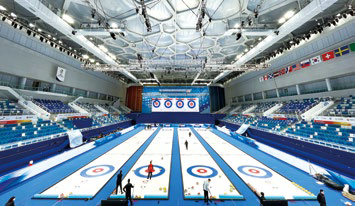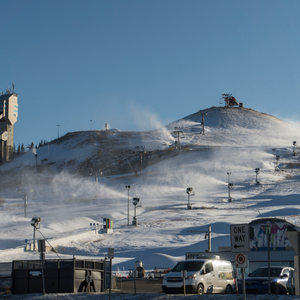This January, the Beijing 2022 Organising Committee published its pre-game sustainability report. The report details the steps taken to reduce and compensate for carbon emissions, protect local ecosystems and provide long-term benefits to the people and economy in the region.
The International Olympic Committee (IOC) has stipulated that the organising committees should be held in a “climate-positive” manner starting from the 2030 summer Olympics. With the mention of sustainability as one of the three main items in the Olympic Agenda announced in 2020, the way has been paved for steps to be taken in this direction. In line with the goals of IOC beyond 2030, Paris 2024 has announced that it will be climate-positive. The 2024 games are the first to benefit from the general framework of the 2020 Olympic Agenda throughout its entire preparation process.
Beijing has pledged to be carbon neutral, in line with the current requirements of the IOC. The Organising Committee stated in the report that many measures were taken to reduce carbon emissions, including low-carbon structures and transportation solutions.
Highlights From the Report
The sustainability plan for the Beijing 2022 Winter Olympic games was first announced in May 2020. According to the calculations made in June 2021, it was predicted that the total basic emissions covering all the processes of the games would be the equivalent to approximately 1.3 million tonnes of carbon dioxide. It is estimated that the largest contribution to emissions will come from constructions, transportation and spectators. The actual value of emissions will be recalculated after the completion of the Olympics.
The Olympic games were held at facilities in three different regions: the capital Beijing, Yanqing and Zhangjiakou. All facilities used in the Olympics were powered by renewable energy sources, primarily solar and wind. According to estimates before the games took place, 400 million kilowatt-hours of green energy will be used from June 2019 until the end of the Paralympic Games in March 2022. This way, emissions equivalent to 320 thousand tonnes of carbon dioxide will be prevented.
In Beijing, which is the first city to host both the summer and winter Olympics for the first time in history, 6 of the facilities used in the 2008 summer Olympics were also used in the winter games. According to the report, while the existing facilities are utilised as much as possible, sustainability was also prioritised in the construction and operation of the newly built facilities. National standards were taken into account while saving energy, water and materials in the design and construction of the buildings.


Curling competitions were held in 2022 in the building that hosted the swimming races at the 2008 Beijing Olympics.
Source: Beijing 2022 Pre-Games Sustainability Report
In the four facilities where ice sports competitions were held, natural carbon dioxide cooling systems, which have a much lower impact on climate compared to traditional cooling methods, were used. Looking at the global warming and ozone depletion potential metrics, carbon dioxide stands out as the safest and most environmentally friendly refrigerant available. Carbon dioxide cooling technology performs the cooling and ice making process stably and evenly by removing heat from the environment as a result of the evaporation of liquid carbon dioxide. The heat generated in the process can be reused for other energy-requiring purposes such as heating water and indoor spaces, and dehumidifying.
Thanks to this technology, in which carbon dioxide is used as a coolant, energy consumption will decrease by more than 20% compared to traditional methods. It is expected that the carbon emissions in the Olympics will be reduced by 900 tonnes with this method according to the Organising Committee. Similarly, the report predicts that up to 20% less water will be consumed to produce artificial snow with the use of smart snow production technologies.

In addition, in order to reduce emissions at the Beijing 2022 Winter Games organisation, approximately 12,000 office equipment and tools such as computers and printers were also rented instead of purchased – where possible. The report also mentions that approximately 85% of the passenger cars used during the Olympic Games are energy saving or clean energy vehicles.
In line with its commitment to hold the carbon neutral Olympic games, Beijing 2022 announced that it will implement carbon emissions trading and set up an emissions assessment and management mechanism. Furthermore, it is stated in the report that afforestation works were carried out in an area of approximately 80,000 hectares in Beijing and Zhangjiakou so as to compensate for carbon emissions.
Do These Make Beijing 2022 a Sustainable Event?
However, while planting works took place in these regions, the selection of Yanqing for the alpine skiing competitions has been criticised by many researchers. The slopes created are in the very centre of the Songshan National Nature Reserve and the facilities are right on the border of the reserve. This raised great concern about how the biological richness of the region may be adversely affected. Nearly 25,000 native trees of 28 different species and nearly 11 thousand plants were transplanted to conservation areas outside their natural habitats to make room for the facilities.

Artificial snow production is the biggest threat to the environment the Winter Olympic games causes. Artificial snow, whose extensive use during the Sochi 2014 and Pyeongchang 2018 winter games stood out, can cause serious ecological damage together as a result of the high water and energy consumption it requires. Now – as the mountainous regions surrounding Beijing receive an average winter precipitation of only 8 millimetres – Beijing 2022 went down in history books by being the first Olympics to be held entirely on artificial snow.
According to the Pre-Games report, it was estimated that approximately 2.8 billion litres of water would be required for the production of artificial snow between November 2021 and March 2022, and 222 million litres of water would be required just during the competitions. The actual amount used will be announced in the post-Olympics report.

However, the damage caused to the environment by artificial snow is not limited to the amount of water used. Great care has to be taken during snow making, especially in windy areas, as the snow blown can fly back to the snow cannons and cause malfunctions. On top of that, Sport Ecology Group‘s Slippery Slopes report makes the point that the chemical composition of artificial snow carries the risk of reducing biodiversity and degrading vegetation.
The arid climate in the region where the Olympics are held and the serious water scarcity due to Beijing being a huge metropolis make the transportation of water for artificial snow production a very difficult and destructive process for the natural life and resources in the region. For instance, water is transported to facilities in Zhangjiakou from a reservoir 29 kilometres away. Moreover, since some parts of the route are uphill, pumping stations have to be installed to deliver the water to the snow machines.
Authorities have stated that they have a vision of turning Zhangjiakou and Yanqing into the nation’s biggest ski resorts mainly because of their close proximity to Beijing. Concrete steps have already been taken to facilitate the transportation to these areas during the preparation for the Olympics. In such a case, the artificial snow and the damage to the environment produced during the Olympics may be very small compared to the damage done in the future.

When all this is taken into account, Beijing 2022 – especially in terms of environmental sustainability – will be far from what the report claims. As a matter of fact, urban and political geographer Sven Daniel Wolfe, who has done research on the sustainability of the Summer and Winter Olympics that have been held since 1992, underlines that the claims of the organisers have not matched reality in the previous Olympics. In addition, his work along with his team at the University of Lausanne has revealed that the sustainability of the Olympic Games in economic, environmental and social dimensions has been worsening.
It is becoming more difficult to avert the negative environmental impact created by the Winter Olympics with each passing day. According to Madeleine Orr from Sport Ecology Group, this turns to an impossible task, especially in regions that are not suitable for winter sports. Winter Olympic Games should, therefore, be held only in venues where the role of artificial snow remains only complementary; in other words where the climate is suitable and access to water is convenient.
For more information:
Beijing 2022 Pre-Games Sustainability Report
Olympic Agenda 2020-Closing Report
Slippery Slopes – How Climate Change is Affecting the Winter Olympics

